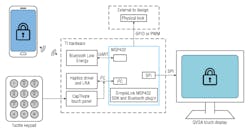Wireless Controls Keep Expanding the Smart Home’s Boundaries
Download this article in PDF format.
Consumers are increasingly adopting various wireless technologies to monitor and control the home environment. The goals of the smart home are greater convenience, energy savings, and safety. Thanks to an amazing selection of wireless technologies, it’s possible to create a wide range of affordable convenience products for the home.
To foster this trend, designers continue to seek viable new products while lowering costs. The secret ingredients of smart home devices are the wireless technology chosen, ease of installation and operation, energy savings if applicable, and of course affordability. Here are some examples of popular products that achieve these basic features.
Sponsored Resources:
- Connecting your smart home devices with Wi-Fi?
- Developing your security system?
- Do you need your designs to span a longer range?
Top Smart Home Applications
It all started with the Nest thermostat. Startup Nest created an innovative programmable thermostat that could replace most existing thermostats and readily provide significant energy savings. The big feature was Wi-Fi that connected the thermostat to the home router. This provided a way to monitor and control the thermostat remotely over the internet. It was a huge success; Google wound up buying the company in 2014.
Today, a thermostat is just one of dozens of Internet of Things (IoT) devices that are finding their way into many homes. Other popular devices include door locks, door bells, security cameras, weather stations, and appliances like refrigerators, washers, and dryers. Even light bulbs can be connected and controlled.
A popular new product category is the smart speaker that incorporates voice recognition and response, such as Amazon Echo, Google Home, and Apple HomePod. These devices allow other devices to be controlled by voice input. Today’s IoT devices are smarter, have more features, and are generally easier to set up and use.
The core components of such IoT devices are microcontrollers (MCUs) and radios. Typically, the MCU and radio are packaged on the same chip. An example is Texas Instruments’ SimpleLink wireless MCU series. Multiple versions provide a good fit with different wireless requirements and processing power.
A Quick Way to Design a Thermostat
The modern IoT thermostat does more than just adjust the temperature. Of course, you do program it to fit your schedule and lifestyle, as well as to save money. The newer thermostats can also sense the presence of people and learn the occupancy patterns of the rooms. In addition to the temperature sensor, some thermostats incorporate a passive-infrared (PIR) sensor plus sensors for humidity, atmospheric pressure, and air quality. An optional voice-recognition and actuation feature can be added externally.
The radio is 802.11b/g/n-compatible, meaning that it connects to the home Wi-Fi router and then to the internet where it can communicate with a cloud server or a cellular network. The monitor, control, and programming can take place via a smartphone with an app over Wi-Fi or a cellular connection. A more recent enhancement is Bluetooth Low Energy (BLE) connectivity for thermostat provisioning.
1. This home thermostat design leverages the SimpleLink CC3220. Note the potential external features such as additional external sensors and a voice activation and response capability.
All of this capability can be demonstrated with TI’s TIDM-1020 thermostat reference design (Fig. 1). At the heart of it is the SimpleLink CC3220 wireless MCU. This system-on-chip (SoC) integrates a Wi-Fi-certified network processor that runs all of the Wi-Fi software and executes the internet layers plus a separate ARM Cortex M4 dedicated to the application. I/O includes a 12-bit analog-to-digital converter (ADC) and multiple interfaces like SPI, I2C, UART, I2S, and GPIO. Low power and robust security features round out the design. The CC3220 is available as an SoC as well as in a complete tested and certified module to save design and test time, eliminate the certification costs, and speed time to market.
How to Design A Door Lock
A smart door lock uses a digital code rather than a key for access. These locks connect by wireless for activation. Such locks are becoming a proven new smart home accessory because of the security, privacy, and convenience they provide. Multiple variations are available.
The simplest smart lock uses BLE for access. The usual unlocking process is carried out by a smartphone in close proximity to the door (Fig. 2). A more popular variation uses Wi-Fi. You can still lock and unlock the door with BLE, but the lock is also Wi-Fi-enabled. It communicates with the home Wi-Fi router. This feature allows you to lock or unlock from anywhere over the internet.
2. Here, the SimpleLink CC2640 SoC is implemented in a Bluetooth-enabled door-lock setup.
Another possibility is to use Zigbee for access. Again, BLE provides short-range access. However, the lock incorporates Zigbee wireless. The Zigbee lock becomes part of the home’s mesh network. It communicates with a ZigBee hub in the home that also serves other devices like light bulbs, appliances, or other security components. The Zigbee hub connects to the home Wi-Fi router for full internet remote access.
Another arrangement applies more to hotels and some commercial properties. It leverages a sub-1-GHz radio system with longer range so that all of the locked ports can be managed from a central gateway. BLE is still the short-range access method.
All of these smart door-lock variants can be implemented with Texas Instruments’ SimpleLink Platform made up of low-power MCUs with a mix of the desired wireless technologies. For the simple BLE lock, the CC2640R2F or CC2642R is a good choice, while the Wi-Fi lock would use the CC3220S or CC3220F (BLE is included with the latter). The Zigbee smart lock could use the CC2652 that also incorporates BLE. The sub-1-GHz proprietary lock could be implemented with the CC1352 or CC1352P. These devices use minimal power and can be battery operated for years.
Achieving Longer Range
The CC1352 devices just mentioned are a good choice for other smart home products that must communicate over a longer distance. These devices communicate in the 2.4-GHz band and the more useful sub-1-GHz frequencies like 868 MHz in Europe and 915 MHz in the U.S. All versions of the device incorporate a higher-power RF amplifier with an output to +20 dBm. The power amplifier and use of sub-1-GHz bands are the secret to the longer range. TI’s CC1352P Launchpad Development Kit provides a way to experiment with this device and long-range products.
Sponsored Resources:
About the Author

Lou Frenzel
Technical Contributing Editor
Lou Frenzel is a Contributing Technology Editor for Electronic Design Magazine where he writes articles and the blog Communique and other online material on the wireless, networking, and communications sectors. Lou interviews executives and engineers, attends conferences, and researches multiple areas. Lou has been writing in some capacity for ED since 2000.
Lou has 25+ years experience in the electronics industry as an engineer and manager. He has held VP level positions with Heathkit, McGraw Hill, and has 9 years of college teaching experience. Lou holds a bachelor’s degree from the University of Houston and a master’s degree from the University of Maryland. He is author of 28 books on computer and electronic subjects and lives in Bulverde, TX with his wife Joan. His website is www.loufrenzel.com.


